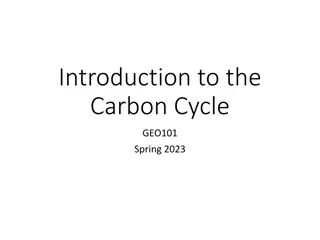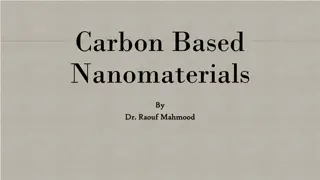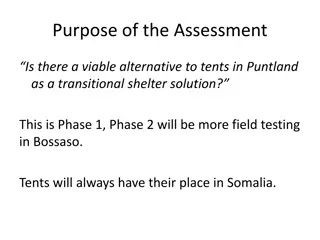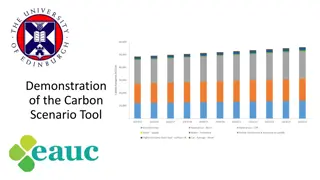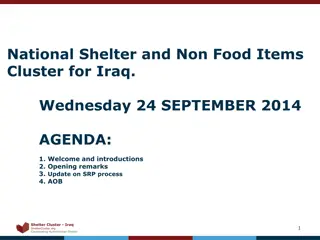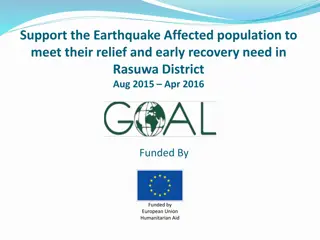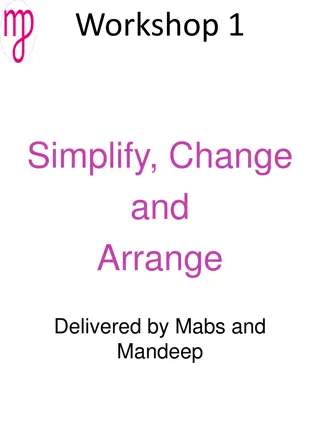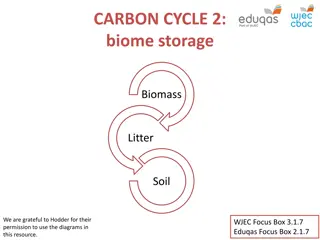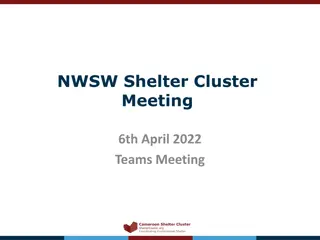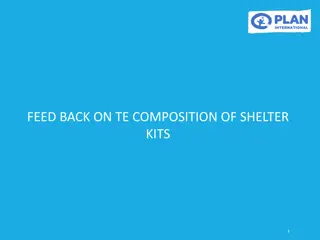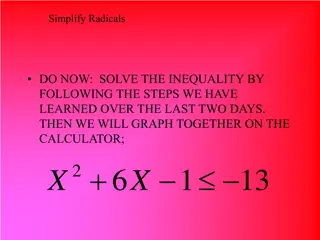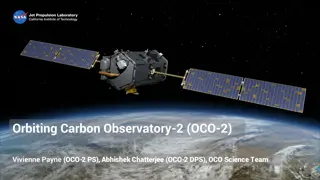SMAC Tool: Simplifying Carbon Assessment for Shelter Solutions
"SMAC, developed by BRE Trust, assists in comparing shelter solutions based on carbon emissions. It allows easy comparison of 4 shelter types on criteria like materials, packaging, transport, and end-of-life considerations. No expert knowledge is needed to use SMAC; simply input shelter components, material quantities, packaging details, and transportation distances. The tool provides a kg CO2eq figure for informed decision-making."
Download Presentation

Please find below an Image/Link to download the presentation.
The content on the website is provided AS IS for your information and personal use only. It may not be sold, licensed, or shared on other websites without obtaining consent from the author.If you encounter any issues during the download, it is possible that the publisher has removed the file from their server.
You are allowed to download the files provided on this website for personal or commercial use, subject to the condition that they are used lawfully. All files are the property of their respective owners.
The content on the website is provided AS IS for your information and personal use only. It may not be sold, licensed, or shared on other websites without obtaining consent from the author.
E N D
Presentation Transcript
Shelter Methodology for the Assessment of Carbon Step-by-Step User Guide
What is SMAC? SMAC has been developed by BRE Trust, the Environment Community of Practice, and WWF-US to support the comparison of shelter solutions in terms of their kg CO2equivalent emissions. It is intended as a decision-support tool to help identify the most carbon-efficient shelter option. It is not: A complete summary of environmental impacts a shelter option may or may not have. An accurate assessment of the kg CO2eq impact for the specific materials used in all parts of the world. A tool designed for use in more complex building structures. It is: A tool for quick comparison of generic options for temporary or transitional shelter options. A provider of a "good enough" comparative metric across sheltering options that can inform decision-making and environmental impact monitoring and reporting.
What is SMAC? SMAC allows for comparison of up to 4 different shelter types in terms of their embodied carbon equivalent emissions on the following criteria. 1. The component materials 2. Packaging 3. Transport 4. End of Life
What do you need to know to use SMAC? SMAC is intended to be simple-to-use, with no expert knowledge required. In order to complete the process and get a kg CO2eq figure for your shelter options, you should know: A list of the shelter components and materials The amount of material used in kg The type of packaging used for the materials The transportation distances and methods from point of source of materials to use and disposal (there is further guidance in the tool on this if accurate distances are not known) The information found in a bill of quantity should be enough to use the tool
Using the SMAC Tool Green boxes denote free text fill boxes, usually for descriptive information or to enter transportation distances Yellow boxes are drop down lists please note that upon opening a drop down list, you may have to scroll to the top of the list in order to see all available options Grey boxes will show results
Using the tool Component Materials Insert the raw materials used in the shelter components, selecting from the drop down lists After selecting the type of material, you will be asked for a more specific sub-set to identify the material used Add the quantity of each material component (in kg)
Using the Tool - Packaging Repeat the process for the packaging materials, selecting from the drop down list the materials used and adding the quantity in kg. This will then give you an overall view of your shelter specifications
Using the Tool - Transport Fill out the transportation table for each stage of transportation this is a manual fill form so enter known distances in kilometres in the correct method of transport column. If these distances are not know, you can refer to the Transport Guide tab in the spreadsheet for a rough distance calculator. *NOTE* Please complete all green cells in transportation section to ensure the formula works if the method of transport is not used, then a 0 should be entered.
Using the SMAC tool End of Life End of life data is calculated based on the entries made in component materials above, information on the data calculation can be found in the End of Life Data tab
Using the Tool Results This is your impact per shelter unit You will then see a breakdown of the KG CO2 equivalent impact per shelter unit, per life cycle stage. This shows the breakdown of where the impact is coming from
Using the Tool - Results This is the output on each of the Spec sheets, showing the percentage breakdown of CO2 impact, which can help to inform decisions about how to reduce the impact of your shelter solution. Here, we see that packaging makes up a larger proportion of the carbon impact than might be expected. Therefore, a reduction in packaging could be considered.
Using the Tool - Results You will also find a breakdown of the relative percentage impact of the different component materials, as entered into the first Component Materials section. Here, you can see that the roof and internal dividers / flooring components account for the majority of impact, whereas the wall materials and paint account for very little kg CO2eq impact. Therefore, if you were looking to reduce the kg CO2eq impact of the component materials, reviewing different options for roofing and flooring is the most appropriate action.
Using the Tool - Comparison You can compare up to four shelter specifications in SMAC by completing the 4 specification sheets and reviewing the Spec Comparison tab.
Comparison Outputs Figure 2: CO2 Impact Breakdown Percentage Per Unit 100% Figure 1: Shelter CO2eq Impact Comparison (Per Unit) 120.00 75% 100.00 KG CO2 eq per unit Kg CO2 eq per unit 80.00 50% 60.00 40.00 25% 20.00 0.00 1 2 3 0% Shelter Specification Specification 1 Raw materials Specification 2 Packaging Specification 3 Transport End of life These are the graphic outputs provided by SMAC for the comparison of these 3 shelter types. On figure 1, you see a comparison of the overall kg CO2 equivalent emissions per unit. On figure 2 is the breakdown for each shelter specification into the four measurement criteria. Shelter spec 2 is clearly having a much larger impact than 1 or 3 in this example, and from reviewing the breakdown we can see that the majority of this increase is due to the transportation distances or methods used. One intervention to reduce the impact of shelter 2 might therefore be to review transportation methods and find an alternative solution.
Interpreting the Results Why kg CO2 equivalent emissions? Measuring lifecycle environmental impact of shelter materials is a complex and time-consuming process. For shelter response, a quick comparison of different options is the most useful metric to help inform decision-making. kg CO2 equivalent emissions can be used as a proxy for environmental footprint, and allows for rapid comparison of some of the expected impacts from different shelter options.
Interpreting the Results The outputs from SMAC should not be taken as an accurate measure of the environmental impact of a specific shelter specification. The figures provided utilise publicly available data and provide a good enough calculation of the expected kg CO2eq emissions for a given input. This tool can help to inform decision-making and highlight potential areas where overall environmental impact might be reduced.
FAQs What is a good / bad kg CO2eq score? The lower the score, the better the result. There is no limit either up or down. Some products, which have sequestrated carbon during their life, can have a negative embodied carbon result. Does every part of the information required need to be completed for an accurate result? In parts of the tool, it is possible to use default values, for example for the transport section. If details of a component are unknown or incomplete, please use the closest match. Information on material uses and potential proxies can be found in the reference list in the tool itself. The results are also not intended as an accurate representation of kg CO2eq impact, but rather a guide based on available data, as highlighted in the reference list. Please note that the results obtained with SMAC are as good as the quality of the information entered. Where has the source data come from? The data from the tool has been taken from the Inventory of Carbon and Energy (ICE database), as well as from various environmental product declarations (EPD, such as those found in Eco Platform and Greenbooklive). The ICE database is a collation of aggregated and EPDs. Where data did not exist in ICE, and one EPD was available, that data point was used. Where several EPDs were available, an average was used. All data sources have been referenced within the tool. Data for packaging, end of life and recycled content have been sourced from BRE.
FAQs If a material I want to use is not in the list, what do I use to continue? Use the closest match available. More information on potential uses and material matches can be found in the reference materials list tab within the tool itself. How often will the list of materials be updated? The materials list as it has been provided by BRE is current as of July 2021. Dates of expiry for EPDs are provided in the reference list. However, the list of materials could be expanded at any time with either more materials or with manufacturers specific data. If you wish to add to the list of materials, please contact Charles Kelly at havedisastercallkelly@gmail.com for access to the open access tool, in order to make changes to the materials list. Life Expectancy Field what value should you enter? The number of years or months the unit is designed to last for. Why is there no option to indicate if wood has been responsibly sourced e.g. FSC? Responsible sourcing of materials is not quantifiable in a life cycle assessment, which does not typically include social or economic impacts.
FAQs Why can t the percentage recycled content value be changed? The relationship between recycled content and environmental impact is not an easy one. If the percentage recycled content of a material is higher to the one stated in the tool, it cannot be assumed that its environmental impact will be decreased. A full environmental impact assessment of that material would need to be recalculated. Hence, it cannot be changed. The percentage recycled content and recycle EOL values are based on which manufacturing region? Both the percentage recycled content and recycled at end of life values are typical of the UK and EU practices. If you are interested in adding more region-specific data to the tool, you can access the editable version by contacting Charles Kelly at havedisastercallkelly@gmail.com.
Find out more Walkthrough video Utilising kg CO2eq in decision-making Chapter 9 of InterAction s Roadmap for Research LCA in the Shelter Sector More information on SMAC s development Reach out to havedisastercallkelly@gmail.com or Stephen.Alexander@bregroup.com for queries
SMAC Disclaimer This tool was developed by BRE Trust and is made publicly available for information purposes only. It is not intended to amount to advice on which you should rely. You must obtain qualified professional or specialist advice before taking, or refraining from, any action on the basis of the outputs from the tool. BRE disclaims against liability associated with the use or interpretation of this tool. Where the user wishes to publish outputs, the user must not do anything to mislead industry, consumers or any third party, or in a way that suggests or infers endorsement, approval or certification by BRE where no such endorsement, approval or certification exists. BRE accepts no responsibility for any unauthorised use or distribution of the SMAC tool.




